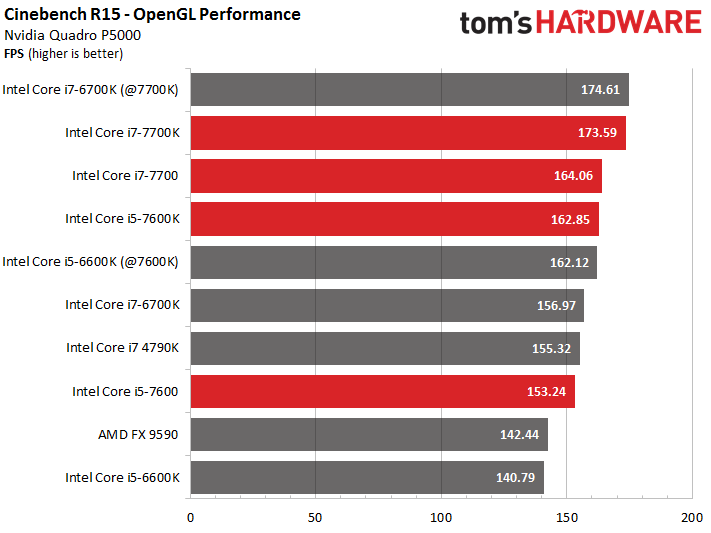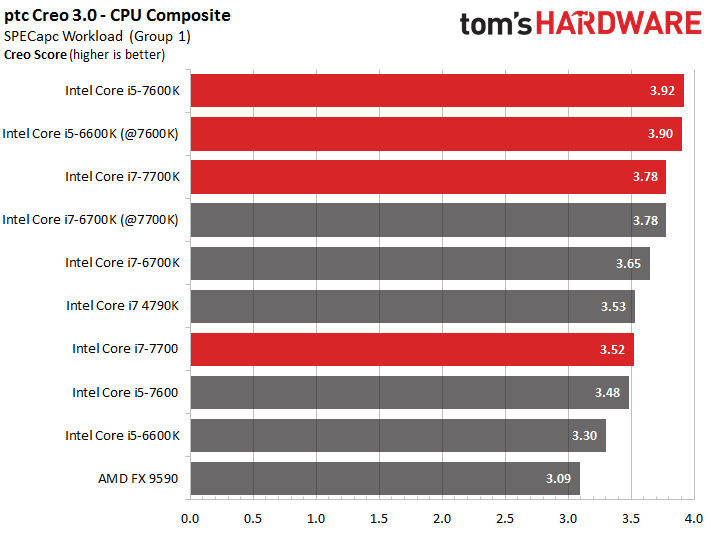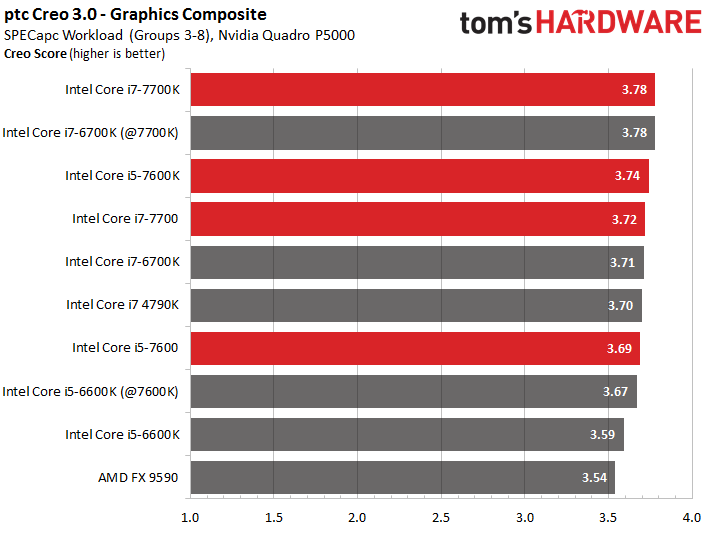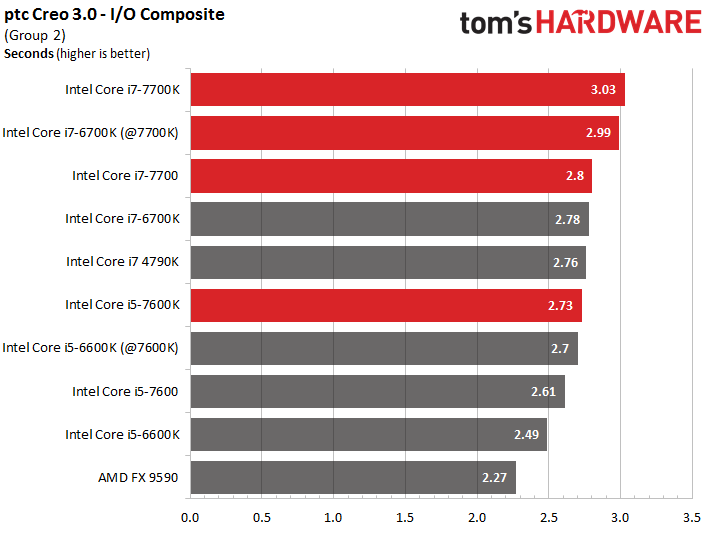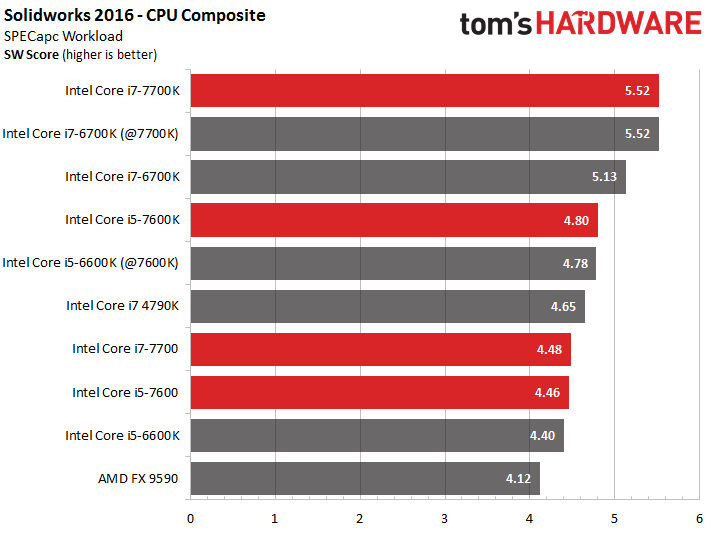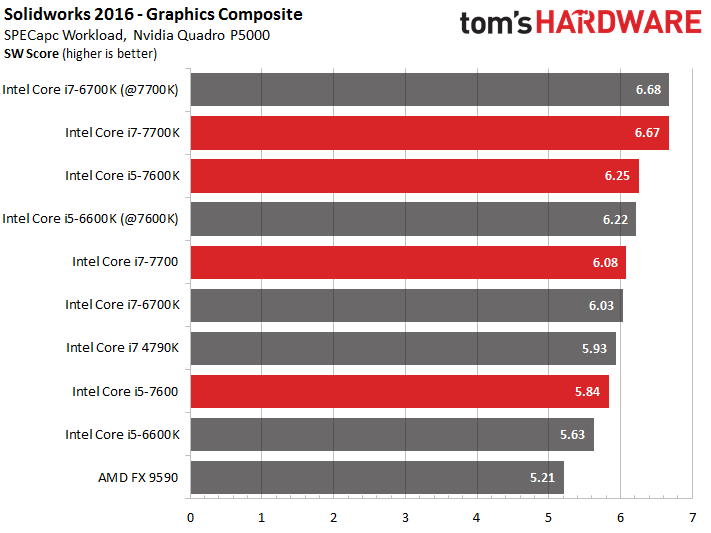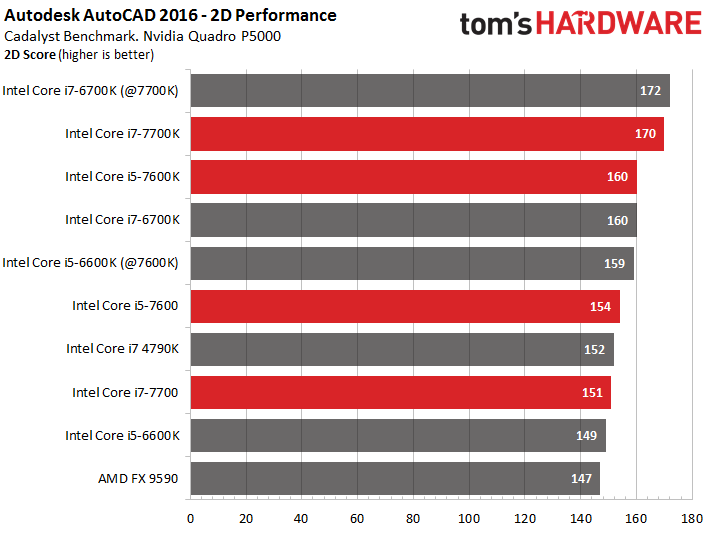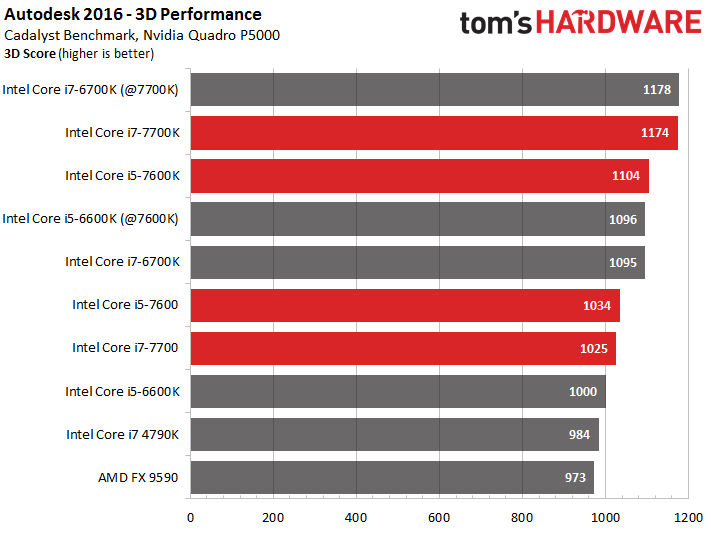Intel Kaby Lake Core i7-7700K, i7-7700, i5-7600K, i5-7600 Review
Results: Workstation Applications
OpenGL: Cinebench R15
We decided to run one more small synthetic benchmark before getting to the heavy hitters: Cinebench R15’s OpenGL benchmark. In this test, clock rate rules and more than four cores aren’t necessary. The results aren’t exactly newsworthy, but they do make for a nice transition to the larger applications.
Creo 3.0
The Creo test’s biggest advantage (and disadvantage, to be honest) is its long run time. The longer a benchmark runs, the more reliable its results tend to be. If the results of different CPUs are still the same after an hour, then there shouldn't be any noticeable differences between them during daily use.
| Header Cell - Column 0 | Description |
|---|---|
| Workflows | CPU Composite (1)I/O Composite (1)Graphic Composite (6) |
| Content | - Open, Generate, Close and Delete Workflows- GPU- and CPU-based Output Computations (Tessellation, Mass Properties Analysis)- All Possible Types of Shading Functions and Movements (Rotate, Pan, Zoom)- Usage of Screen Space Ambient Occlusion (SSAO)- Bump Mapping and Image Background Support- Snapshots |
Let’s take a look at the three composite results of the individual benchmarks, starting with CPU performance. Once again, the eight simulated threads are more of a hindrance than an asset. True quad-core CPUs fare significantly better. However, this is only the case for pure CPU testing, which doesn’t provide us with the whole picture.
If we’re looking at the visible results instead, which is limited to the graphical output, then SMT doesn’t matter that much and higher clock rates are all you want. This means that the equivalent Kaby Lake and Skylake models with the same number of physical cores generate the same performance.
The I/O composite numbers round out the results and paint a similar picture. Kaby Lake’s only advantage over its predecessor comes from higher frequencies. Anyone considering an upgrade should spend some time thinking about the value story here. Otherwise, you'll end up spending a lot of money going sideways instead of stepping up.
Solidworks 2016
Solidworks by Dassault Systems is also very CPU-dependent. Additionally, it’s a benchmark that runs for long periods of time and doubles as a stress test. Overclocked CPUs are actually more likely to show errors during this benchmark than during the more common Prime95 or OCCT runs.
| Header Cell - Column 0 | Description |
|---|---|
| Workflows | CPU Composite (2 Tests)Graphic Composite (9 Tests) |
| Content | CPU- Tessellation- PhotoView360 RenderingGPU- RealView- Ambient Occlusion On- Shadows- Up to 4.75 Million Triangles- Order Independent Transparency (OIT) |
The CPU composite results show very clearly that processors able to work on lots of threads at high clock rates have the advantage. SMT is a big help as well. In this case, the benchmark tasks consisted of CPU-based tessellation and rendering.
Get Tom's Hardware's best news and in-depth reviews, straight to your inbox.
Conversely, graphics output performance depends primarily on a CPU’s frequency and IPC throughput. This makes the comparison between Kaby Lake and Skylake at the same clock rates a worthwhile endeavor.
AutoCAD 2016
This software suite is a classic that runs well on consumer graphics cards since DirectX is used for 3D rendering instead of OpenGL.
Ever since the introduction of the unified shader model, graphics cards haven’t included specialized 2D hardware. Also, hardware-based 2D commands are all but extinct due to the driver model of all Windows versions since Vista. This means that many steps need to be computed by the CPU before a direct output can be executed. So, the 2D test exposes even the smallest weakness in IPC performance.
There’s a small difference between Kaby Lake and Skylake CPUs in 2D, but it vanishes completely in 3D. Once again, multi-threading doesn’t really provide an advantage. The clock rate's really all that matters.
Current page: Results: Workstation Applications
Prev Page Results: Rendering And Office Applications Next Page Results: DTP And Multimedia
Igor Wallossek wrote a wide variety of hardware articles for Tom's Hardware, with a strong focus on technical analysis and in-depth reviews. His contributions have spanned a broad spectrum of PC components, including GPUs, CPUs, workstations, and PC builds. His insightful articles provide readers with detailed knowledge to make informed decisions in the ever-evolving tech landscape
-
Based on our initial testing, we can confirm that HD Graphics 630 does not function correctly under Windows 7 and 8.1. Both operating systems install generic drivers for the display adapter, even after applying the latest drivers and updates, so many core features remain unavailable. We also experienced stability issues with Windows 7 that might even negate using an add-in GPU as a workaround.Reply
Not true, i setup Kaby Lake in my lab and everything works fine under Windows 7. Did you guys even try to apply drivers for HD Graphic 630? -
adgjlsfhk It would have been kind of nice to see igpu vs gtx 750 and other low end discrete graphics cards, but other than that, great review.Reply -
cknobman Boooooooooooooooooring.Reply
Bring on the new AMD cpu's!!!
Oh, nice review the boring is not Toms fault ;) -
Jim90 "Intel’s slow cadence of incremental upgrades hasn’t done much to distance its products from AMD's.Reply
"...Obviously we need a competitive AMD to help reinvigorate the desktop PC space."
Without real competition the only risk Intel takes with the Desktop market is to loose sight of (i.e. actively ignore) the performance jump the consumer expects in a new release. Continual and lengthy minor incremental updates (pretty much what we've seen since the 2000 series) may well lead to consumer apathy. I certainly haven't upgraded 'as much as I could!' recently. Absolutely no justifiable need.
Then again, perhaps we've all had access to enough power we need? We used to talk about 'killer apps/software' to drive consumers into making a purchase. This certainly did work. Maybe new tech (currently available) isn't killer enough? We need another '3dfx Voodoo' experience?
VR is certainly (definite?) a potential driver...here's hoping for speedy and significant updates here. -
Paul Alcorn Reply19098433 said:Based on our initial testing, we can confirm that HD Graphics 630 does not function correctly under Windows 7 and 8.1. Both operating systems install generic drivers for the display adapter, even after applying the latest drivers and updates, so many core features remain unavailable. We also experienced stability issues with Windows 7 that might even negate using an add-in GPU as a workaround.
Not true, i setup Kaby Lake in my lab and everything works fine under Windows 7. Did you guys even try to apply drivers for HD Graphic 630?
Hello, yes we did test and attempt to install the HD Graphics 630 drivers. We are working with early BIOS revisions, so it is possible that we encountered a platform-specific issue. Can you share which motherboard you used for your testing? Any feedback is welcome.
-
ohim Why are they even releasing this ? It makes absolutely no sense to release such a product ...Reply -
redgarl Reply19098782 said:Why are they even releasing this ? It makes absolutely no sense to release such a product ...
Probably to make a statement of some kind.
-
FormatC Reply
You really have drivers for the Z270 chipset with official support of Windows 7 from intel and Microsoft? I tried it also and was not able to run KL with all features on a W7 installation. It runs, somehow. :)19098433 said:Not true, i setup Kaby Lake in my lab and everything works fine under Windows 7. Did you guys even try to apply drivers for HD Graphic 630? -
valeman2012 Just notice that people that are using these CPU you need Windows 10 to have everything working 100%.Reply
